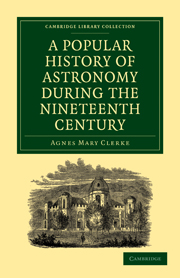Book contents
- Frontmatter
- PREFACE
- Contents
- INTRODUCTION
- Part I PROGRESS OF ASTRONOMY DURING THE FIRST HALF OF THE NINETEENTH CENTURY
- Part II RECENT PROGRESS OF ASTRONOMY
- CHAPTER I FOUNDATION OF ASTRONOMICAL PHYSICS
- CHAPTER II SOLAR OBSERVATIONS AND THEORIES
- CHAPTER III RECENT SOLAR ECLIPSES
- CHAPTER IV SPECTROSCOPIC WORK ON THE SUN
- CHAPTER V TEMPERATURE OF THE SUN
- CHAPTER VI THE SUN'S DISTANCE
- CHAPTER VII PLANETS AND SATELLITES
- CHAPTER VIII PLANETS AND SATELLITES (continued)
- CHAPTER IX THEORIES OF PLANETARY EVOLUTION
- CHAPTER X RECENT COMETS
- CHAPTER XI RECENT COMETS (continued)
- CHAPTER XII STARS AND NEBULÆ
- CHAPTER XIII METHODS OF RESEARCH
- INDEX
CHAPTER V - TEMPERATURE OF THE SUN
Published online by Cambridge University Press: 07 September 2011
- Frontmatter
- PREFACE
- Contents
- INTRODUCTION
- Part I PROGRESS OF ASTRONOMY DURING THE FIRST HALF OF THE NINETEENTH CENTURY
- Part II RECENT PROGRESS OF ASTRONOMY
- CHAPTER I FOUNDATION OF ASTRONOMICAL PHYSICS
- CHAPTER II SOLAR OBSERVATIONS AND THEORIES
- CHAPTER III RECENT SOLAR ECLIPSES
- CHAPTER IV SPECTROSCOPIC WORK ON THE SUN
- CHAPTER V TEMPERATURE OF THE SUN
- CHAPTER VI THE SUN'S DISTANCE
- CHAPTER VII PLANETS AND SATELLITES
- CHAPTER VIII PLANETS AND SATELLITES (continued)
- CHAPTER IX THEORIES OF PLANETARY EVOLUTION
- CHAPTER X RECENT COMETS
- CHAPTER XI RECENT COMETS (continued)
- CHAPTER XII STARS AND NEBULÆ
- CHAPTER XIII METHODS OF RESEARCH
- INDEX
Summary
Newton was the first who attempted to measure the quantity of heat received by the earth from the sun. His object in making the experiment was to ascertain the temperature encountered by the comet of 1680 at its passage through perihelion. He found it, by multiplying the observed heating effects of direct sunshine according to the familiar rule of the “inverse squares of the distances,” to be about 2000 times that of red-hot iron.
Determinations of the sun's thermal power made with some scientific exactness, date, however, from 1837. A few days previous to the beginning of that year, Herschel began observing at the Cape of Good Hope with an “actinometer,” and obtained results agreeing quite satisfactorily with those derived by Pouillet from experiments made in France some months later with a “pyrheliometer.” Pouillet found that the vertical rays of the sun falling on each square centimetre of the earth's surface are competent (apart from atmospheric absorption) to raise the temperature of 1.7633 grammes of water one degree centigrade per minute. This number (1.7633) he called the “solar constant;” and the unit of heat chosen is known as the “calorie.” Hence it was computed that the total amount of solar heat received during a year would suffice to melt a layer of ice covering the entire earth to a depth of 30.89 metres, or 100 feet; while the heat emitted would melt, at the sun's surface, a stratum 11.80 metres thick each minute.
- Type
- Chapter
- Information
- A Popular History of Astronomy During the Nineteenth Century , pp. 257 - 268Publisher: Cambridge University PressPrint publication year: 2010First published in: 1885



